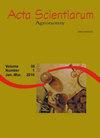The management of phosphate fertilization affects soil phosphorus and yield of autumn/winter crops
IF 1.2
4区 农林科学
Q3 AGRONOMY
引用次数: 0
Abstract
In soils with adequate levels of fertility, it is possible to manage phosphate fertilization aiming at the grain production system, instead of each isolated crop. The objective was to evaluate the effects of the management of phosphate fertilization, place and time, on the soil and leaf P content, and crop yield in grain production systems. An experiment was conducted at the farm level in the municipality of Nazareno, state of Minas Gerais, Brazil, for four years on soil with adequate level of fertility. The treatments consisted of the management of phosphate fertilization by broadcast or furrow and dose for each crop or for the production system (spring/summer and autumn/winter crops), being: Control = without phosphate fertilization; Conventional = phosphate fertilization in the furrow in each crop; BTP = phosphate fertilization of the grain production system to broadcast; TPS = phosphate fertilization of the grain production system in the furrow of the spring/summer crop; TPW = phosphate fertilization of the grain production system in the furrow of the autumn/winter crop. Soil P content was evaluated in the third year of implantation, and the crops yield every season crop (maize, soybean, common bean and wheat). The P content in the leaves of maize and soybeans were evaluated in the spring/summer crops. The application of the total dose of phosphate fertilization for both crops in the sowing furrow of the spring/summer or autumn/winter crops (TPS and TPW) promoted operational advantages and increased soil P content in the 0-0.20 m layer, without reducing the yield of the spring/summer crops. Leaf P content was not affected. The Conventional management (phosphate fertilization in the furrow in each crop) provide greater yield of common beans and wheat during autumn/winter crops, which are more subject to water restriction due to less rainfall, even without increasing the soil P content.磷肥管理影响土壤磷和秋冬作物产量
在肥力充足的土壤中,可以针对粮食生产系统施用磷肥,而不是针对每一种孤立的作物。目的是评价磷肥管理、地点和时间对粮食生产系统中土壤和叶片磷含量以及作物产量的影响。在巴西米纳斯吉拉斯州纳扎雷诺市的农场一级,在肥沃的土壤上进行了为期四年的试验。处理包括对每一种作物或生产系统(春/夏和秋/冬作物)进行撒播或沟施磷肥和剂量管理,即:控制=不施用磷肥;常规=在每一种作物的犁沟中施用磷肥;BTP =磷肥对粮食生产系统进行撒播;TPS =粮食生产系统春夏作物垄沟磷肥;粮食生产系统在秋冬作物犁沟中施磷肥。在种植第3年对土壤磷含量进行评价,并对每季作物(玉米、大豆、普通豆和小麦)的产量进行评价。对春夏作物玉米和大豆叶片磷含量进行了评价。春/夏或秋/冬作物播沟施磷肥总剂量(TPS和TPW)促进了0-0.20 m层土壤磷含量的操作优势,且不降低春/夏作物的产量。叶片磷含量不受影响。常规管理(每株作物犁沟施磷肥)在秋冬作物期间提供了更高的产量,但由于降雨较少,这些作物更容易受到水分限制,即使没有增加土壤P含量。
本文章由计算机程序翻译,如有差异,请以英文原文为准。
求助全文
约1分钟内获得全文
求助全文
来源期刊

Acta Scientiarum. Agronomy.
Agricultural and Biological Sciences-Agronomy and Crop Science
CiteScore
2.40
自引率
0.00%
发文量
45
审稿时长
>12 weeks
期刊介绍:
The journal publishes original articles in all areas of Agronomy, including soil sciences, agricultural entomology, soil fertility and manuring, soil physics, physiology of cultivated plants, phytopathology, phyto-health, phytotechny, genesis, morphology and soil classification, management and conservation of soil, integrated management of plant pests, vegetal improvement, agricultural microbiology, agricultural parasitology, production and processing of seeds.
 求助内容:
求助内容: 应助结果提醒方式:
应助结果提醒方式:


